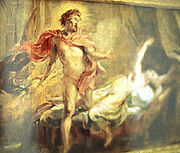Semele, also known as Thyone, was a Theban princess born to Cadmus and Harmonia. She had three sisters (who, ironically, also had some kind of tragedy as well): Agave, Ino, and Autonoe. She is best known for her role as the mother of Dionysus, the Olympian god of wine and merriment.
In Mythology[]

Zeus appearing to Semele
In most versions of Greek mythology, Semele was the mother of Dionysus.
Zeus fell madly in love with Semele and slept with her in secret. Zeus's vengeful wife Hera soon found out about the affair when she saw that Semele was pregnant. She disguised herself as a maid and convinced Semele to demand Zeus reveal himself in his glorified form to her as he does with the queen of the gods, Hera. Semele fulfilled this, specifying the request in an unidentified form, and Zeus swore by the River Styx that anything she asked of him he would do. When she finally revealed her request, Zeus knew that no mortal could behold him and live, but he also knew there was nothing he could do; he took the oath of the sacred River Styx, an oath that not even he could go back on. He came as she requested, and the mortal woman died before the burning light of his glory.
Her conceived child Dionysus, however, survived Zeus's presence because he was half-god himself. Zeus snatched the child from his mother's ashes and had it sewn to his thigh until it was ready to be born. Because of this conception, this is why Dionysus is called the "twice-born"; he was conceived and released from his mother's stomach, and then again on his father's thigh.
Dionysus was raised at first by Semele's sister and brother-in-law, Ino and Athamus, and then was later taken by Hermes to the nymphs of Nysa, the loveliest of earth's valleys that no man can find or has ever seen.[1] Once grown and a god, Dionysus retrieved his mother from Hades and made her a goddess by the name of Thyone. However, in some cases Semele remains as a shade in Hades' realm.
See also[]
Citations[]
- ↑ (Hamilton 1998, p. 56)
References[]
- http://www.pantheon.org/
- Hamilton, Edith (1998), Mythology, Back Bay Books, New York, ISBN 0-316-34151-7
| Deities in Greek mythology | |
|---|---|
| Protogenoi | Chaos • Gaia • Tartarus • Uranus • Erebos • Nyx • Aether • Hemera • Eros • Oceanus • Pontus • Thalassa |
| Titans | Atlas • Cronus • Mnemosyne • Prometheus • Rhea • Tethys • Themis • Metis • Hecate • Eos • Helios • Selene |
| Twelve Olympians | Zeus • Hera • Demeter • Hestia • Poseidon • Ares • Artemis • Apollo • Athena • Hermes • Hephaestus • Aphrodite • Dionysus |
| Daemones | Bia • Dike • Eris • Hebe • Hygieia • Hypnos • Nemesis • Nike • Phobos • Poena • Soteria • Thanatos |
| Gods and goddesses of Roman mythology | |
|---|---|
| Classical deities | Apollo • Bacchus/Liber • Diana • Ceres • Cupid • Faunus • Fortuna • Juno • Jupiter • Lares • Mars • Mercury • Minerva • Neptune • Pluto • Proserpina • Quirinus • Vejovis • Venus • Vesta • Vulcan |
| Other deities/articles | Genius • Hercules • Dei Lucrii • Eventus Bonus • Furina • Portunes • Mystery religions • Osirus • Isis • Cybele • Attis • Mithras • Sol Invictus |
